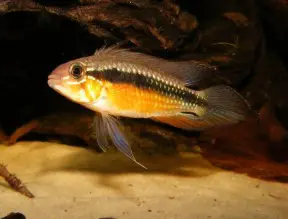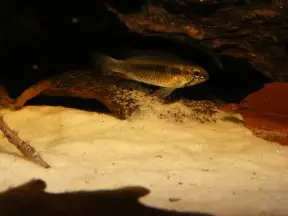Apistogramma elizabethae
A208
Etymology
Apistogramma: from the Greek apisto, meaning ‘meaning uncertain, inconstant, unstable, faithless’, and gramme, meaning ‘line’, in reference to the variably-developed lateral line in member species.
Classification
Order: Perciformes Family: Cichlidae
Distribution
Described from the lower rio Uaupés, Amazonas state, northwestern Brazil and appears to occur only in that drainage and the adjacent rio Içana, both of which are tributaries of the upper rio Negro system.
Type locality is ‘affluent of Rio Uaupés at Trovao, about 20 kilometers from mouth of Uaupés, 0°02’N, 67°26’W, Amazonas State, Brazil’.
Habitat
Tends to inhabit slower-moving tributaries, backwaters and creeks in areas where fallen leaf litter collects.
It occurs sympatrically with the congeners A. brevis, A. meinkeni and A. uapesi.
Maximum Standard Length
40 – 50 mm.
Aquarium SizeTop ↑
Base dimensions of 45 ∗ 30 cm or more are acceptable for a single pair with a group requiring larger quarters.
Maintenance
Provided adequate cover and structure is available this species is unfussy with regards to décor with ceramic flowerpots, lengths of plastic piping and other artificial materials all useful additions.
A more natural-looking arrangement might consist of a soft, sandy substrate with wood roots and branches placed such a way that plenty of shady spots and caves are formed.
The addition of dried leaf litter provides additional cover and spawning sites, and brings with it the growth of beneficial microbe colonies as decomposition occurs.
These can provide a valuable secondary food source for fry, while the tannins and other chemicals released by the decaying leaves aid in simulation of natural conditions. Alder cones may also be used for the latter purpose.
Fairly dim lighting is recommended and aquatic plant species that can survive under such conditions such as Microsorum, Taxiphyllum or Cryptocoryne spp. may be added, while floating vegetation, especially Ceratopteris spp., is also useful.
There is no need to use peat, the collection of which is both unsustainable and environmentally-destructive.
Filtration need not be too strong, with an air-powered sponge filter or similar adequate.
It goes without saying that these are fishes are sensitive to fluctuating organic wastes and should never be introduced to biologically-immature aquaria.
This species also requires require acidic conditions with negligible carbonate hardness and very low general hardness so a reverse osmosis unit or other method of obtaining soft water may need to be employed, and this can be further acidified using phosphoric acid or similar if necessary.
Water Conditions
Temperature: 23 – 29 °C
pH: 4.0 – 6.0
Hardness: 18 – 54 ppm
Diet
Apistogramma spp. are chiefly carnivorous and feed mostly on benthic invertebrates in nature.
In the aquarium live and frozen foods such as Artemia, Daphnia, Moina and chironomid larvae (bloodworm) should be offered regularly although most species will also learn to accept dried alternatives with pelleted products generally preferred to flake.
Behaviour and CompatibilityTop ↑
Best maintained alone or with small ‘dither’ fishes such as Nannostomus spp., and ideally should not be mixed with other Apistogramma.
Sexual Dimorphism
Males are larger, more colourful and develop more extended fins than females.
Reproduction
Substrate spawner which normally lays its eggs in crevices or cavities among the décor.
The female is mostly responsible for post-spawning care of eggs and fry and in smaller aquaria the male may need to be removed as she may become hyper-aggressive.
While spawning this species is not difficult under the correct conditions, raising the fry during the early weeks of life may present difficulties since they’re highly sensitive to changes in water chemistry.
Successful breeders tend to recommend feeding several small meals daily and performing regular, but never large, partial water changes.
NotesTop ↑
This species is assigned the code A208 under the DATZ ‘A’ number system and is among the more sought after Apistogramma spp. in the aquarium hobby.
The form from the rio Içana tends to have more blue markings on the head than that from the Uaupés, while a reddish population apparently collected close to the settlement of Tucana (sometimes mis-spelled ‘Tucano’) on the Uaupés is sometimes traded as A. elizabethae ‘super red’.
Yellowish and greenish forms also exist and none of them should be mixed in aquaria.
Following Römer (2006) it can be told apart from other members of the genus by the following combination of characters: anterior dorsal-fin rays with pointed membranes of which the distal third is unattached; membranes of the first five hard dorsal-fin rays slightly enlarged in females, greatly enlarged in males; presence of two bold lateral spots on each flank; lateral stripe at least 1½ scales in depth; abdominal bands often visible; caudal fin with vertical bars in females, restricted to central portion of fin in males.
In addition the caudal-fin morphology in males changes considerably as the fish age, being rounded in juveniles, lyrate in subadults and lanceolate in adults.
Apistogramma is among the most speciose of South American cichlid genera with around 70 species valid at present but many more awaiting description.
In addition many species exist in two or more geographical colour forms which may or may not turn out to be distinct in the future.
Hobbyists tend to label these with collection data if available in order to avoid mixing them and the potential of hybridisation.
Member species have also been organised into a series of species lineages, complexes and groups by authors in order to better separate them.
Such lists have been augmented by fish that have appeared in the aquarium trade and are in a state of near-constant flux.
For example the A. elizabethae group is contained within the A. agassizi sublineage of the larger A. trifasciata lineage alongside the A. gibbiceps, A. bitaeniata, A. agassizi and A. diplotaenia groups.
Apistogramma and a number of related genera are often included in the putative subfamily Geophaginae.
Kullander (1998) conducted a morphology-based phylogenetic study in which the neotropical Cichlidae was divided into six subfamilies of which the Geophaginae contained 16 genera divided among three ‘tribes’:
Acarichthyini – Acarichthys and Guianacara.
Crenicaratini – Biotoecus, Crenicara, Dicrossus and Mazarunia.
Geophagini – Geophagus, Mikrogeophagus, ‘Geophagus‘ brasiliensis group, ‘Geophagus‘ steindachneri group, Gymnogeophagus, Satanoperca, Biotodoma, Apistogramma, Apistogrammoides and Taeniacara.
Later molecular studies by Farias et al. (1999, 2000, 2001) resulted in the additions of Crenicichla and Teleocichla to the Geophaginae, a result supported by López-Fernández et al. (2005) who conducted the most detailed molecular analysis of the grouping to date including 16 of the 18 genera and 30 species.
However their conclusions regarding interrelationships between genera did vary somewhat from previous hypotheses and can be summarised by the following loosely-defined groups:
– a weakly-supported sister group relationship between Acarichthys and Guianacara.
– a well-supported “Satanoperca clade” comprising Satanoperca, Apistogramma, Apistogrammoides and Taeniacara.
– a “big clade” with Geophagus, Mikrogeophagus, ‘Geophagus‘ brasiliensis group, ‘Geophagus‘ steindachneri group, Gymnogeophagus, Biotodoma, Crenicara and Dicrossus.
– a “crenicarine clade” with Biotoecus and Crenicichla.
No representatives of Teleocichla or Mazarunia were included in the study but the former is well-established as sister to Crenicichla while the latter has grouped closely with Dicrossus and Crenicara in earlier works.
The other main conclusions of the paper are confirmation that Geophaginae is a monophyletic group exhibiting strong signs of having undergone rapid adaptive radiation.
References
- Kullander, S. O., 1980 - Bonner Zoologische Monographien No. 14: 1-152
A taxonomical study of the genus Apistogramma Regan, with a revision of Brazilian and Peruvian species (Teleostei: Percoidei: Cichlidae). - Farias, I. P., G. Ortí, I. Sampaio, H. Schneider and A. Meyer, 1999 - Journal of Molecular Evolution 48(6): 703-711
Mitochondrial DNA phylogeny of the family Cichlidae: monophyly and fast molecular evolution of the Neotropical assemblage. - Farias, I. P., G. Ortí, I. Sampaio, H. Schneider and A. Meyer, 2001 - Journal of Molecular Evolution 53(2): 89-103
The cytochrome b gene as a phylogenetic marker: the limits of resolution for analyzing relationships among cichlid fishes. - López-Fernández, H., R. L. Honeycutt, M. L. J. Stiassny and K. O. Winemiller, 2005 - Zoologica Scripta 34(6): 627-651
Morphology, molecules, and character congruence in the phylogeny of South American geophagine cichlids (Perciformes, Labroidei). - Reis, R. E., S. O. Kullander and C. J. Ferraris, Jr. (eds), 2003 - EDIPUCRS, Porto Alegre: i-xi + 1-729
Check list of the freshwater fishes of South and Central America. CLOFFSCA. - Römer, U., 2006 - Mergus Verlag GmbH: 1-1320
Cichlid Atlas: v. 2 - Wise, M., 2011 - World Wide Web electronic publication, http://apisto.sites.no: Accessed on 13.02.17
Apistogramma Species List By Species-Groups/Complexes.



